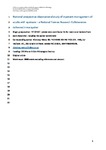National prospective observational study of inpatient management of adults with epistaxis – a National Trainee Research Collaborative delivered investigation
| dc.contributor.author | Mehta, N | |
| dc.contributor.author | Stevens, Kara | |
| dc.contributor.author | Smith, ME | |
| dc.contributor.author | Williams, RJ | |
| dc.contributor.author | Ellis, M | |
| dc.contributor.author | Hardman, JC | |
| dc.contributor.author | Hopkins, C | |
| dc.date.accessioned | 2019-05-24T09:21:23Z | |
| dc.date.available | 2019-05-24T09:21:23Z | |
| dc.date.issued | 2019-06 | |
| dc.identifier.issn | 0300-0729 | |
| dc.identifier.issn | 1996-8604 | |
| dc.identifier.uri | http://hdl.handle.net/10026.1/14207 | |
| dc.description.abstract |
BACKGROUND: There is a paucity of high-quality evidence relating to the management of epistaxis severe enough to require admission to a hospital. Previous studies of interventions for epistaxis have suffered from small sample sizes. They lacked the power to allow analysis of the effect of an intervention on epistaxis control that is independent of the condition severity or additional interventions given. OBJECTIVE: To determine the effect of specialist treatments on the successful management of severe epistaxis METHODOLOGY: Secondary analysis of data collected from a national multi-centre audit of patients with epistaxis over 30 days in 2016. Data were entered prospectively, and patients were followed up for 30 days following hospital discharge. 1402 adults admitted for inpatient management of epistaxis were identified in 113 participating UK hospitals, with data entered prospectively during the 30-day audit window. Exposure variables assessed included treatment instigated at first ENT review, intervention strategy during hospitalization, disease factors (e.g. severity), patient risk factors (e.g. co-morbidities, medications) and treatment factors (grade of doctor, therapies initiated during hospital stay). Main Outcomes include treatment time (time from first ENT review to time haemostasis was achieved and patient was safe for hospital discharge) and 30-day hospital readmission rate. RESULTS: 834 patients had sufficient data for inclusion. Patients who did not receive nasal cautery at first specialist review had a treatment time greater than double the time of those who were cauterised: Adjusted ratio (aR) 2.5 (95% CI 1.7-3.3), after controlling for age, bleeding severity, and whether they received a nasal pack or not. Only 30% of patients received management that complied with new national guidance, but those that did were 87% more likely to be achieve haemostasis before those that did not, even after controlling for bleeding severity. Type of treatment, whether initial intervention or management strategy, did not affect 30-day re-attendance. CONCLUSIONS: Analysis of national audit data suggest that cautery at first specialist review, and management according to national guidance can reduce hospital treatment times without compromising 30-day re-attendance. Future work should investigate why early nasal cautery is infrequently used, and how service delivery can be optimised to allow widespread implementation of evidence-based management for epistaxis. | |
| dc.format.extent | 0-0 | |
| dc.format.medium | ||
| dc.language | eng | |
| dc.language.iso | en | |
| dc.publisher | Rhinology | |
| dc.subject | epistaxis | |
| dc.subject | management | |
| dc.subject | adults | |
| dc.subject | prospective | |
| dc.subject | cautery | |
| dc.title | National prospective observational study of inpatient management of adults with epistaxis – a National Trainee Research Collaborative delivered investigation | |
| dc.type | journal-article | |
| dc.type | Journal Article | |
| dc.type | Observational Study | |
| plymouth.author-url | https://www.webofscience.com/api/gateway?GWVersion=2&SrcApp=PARTNER_APP&SrcAuth=LinksAMR&KeyUT=WOS:000469865400004&DestLinkType=FullRecord&DestApp=ALL_WOS&UsrCustomerID=11bb513d99f797142bcfeffcc58ea008 | |
| plymouth.issue | 0 | |
| plymouth.volume | 0 | |
| plymouth.publication-status | Published online | |
| plymouth.journal | Rhinology journal | |
| dc.identifier.doi | 10.4193/rhin18.239 | |
| plymouth.organisational-group | /Plymouth | |
| plymouth.organisational-group | /Plymouth/Faculty of Health | |
| plymouth.organisational-group | /Plymouth/REF 2021 Researchers by UoA | |
| plymouth.organisational-group | /Plymouth/REF 2021 Researchers by UoA/UoA03 Allied Health Professions, Dentistry, Nursing and Pharmacy | |
| plymouth.organisational-group | /Plymouth/Research Groups | |
| plymouth.organisational-group | /Plymouth/Research Groups/Institute of Health and Community | |
| dc.publisher.place | Netherlands | |
| dcterms.dateAccepted | 2018-11-26 | |
| dc.rights.embargodate | 2019-6-4 | |
| dc.identifier.eissn | 1996-8604 | |
| dc.rights.embargoperiod | Not known | |
| rioxxterms.versionofrecord | 10.4193/rhin18.239 | |
| rioxxterms.licenseref.uri | http://www.rioxx.net/licenses/all-rights-reserved | |
| rioxxterms.licenseref.startdate | 2019-06 | |
| rioxxterms.type | Journal Article/Review |


